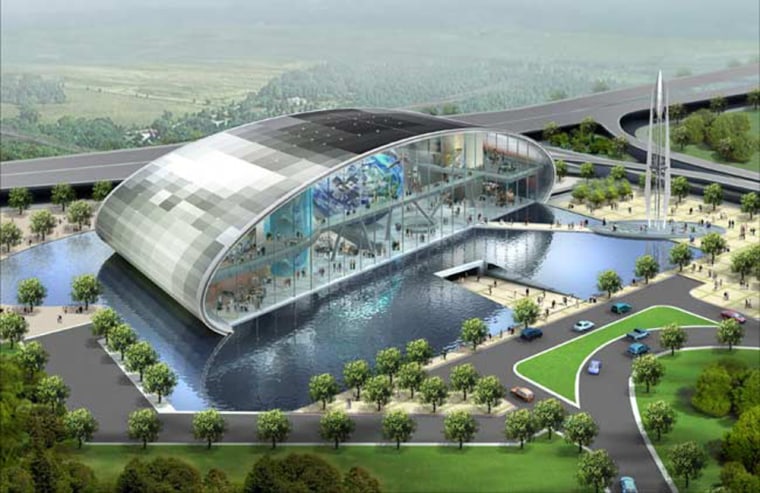An effort to build a suborbital spaceport destination to cater to space-hungry tourists and families is pushing forward in Singapore, where aviation authorities are developing a homegrown set of regulations for commercial spaceflight.
The Civil Aviation Authority of Singapore (CCAS) is laying the groundwork here for the rules to govern flights out of Spaceport Singapore, a planned $115 million (SGD $191 million) project to offer suborbital spaceflights and a host of other experiences to adventure-seeking tourists.
"Commercial passenger suborbital spaceflight is very new to Singapore and for [the] CAAS," said Constanze Chia, assistant manager of corporate communications for Singapore’s aviation authority, in a statement. "We are in the initial stage of formulating the appropriate set of regulations."
Slated to open in 2009, Spaceport Singapore is the brainchild of a consortium of investors and the Virginia-based adventure tourism firm Space Adventures, which announced the project — alongside plans for a United Arab Emirates spaceport and a fleet of suborbital Explorer spacecraft — earlier this year.
Space Adventures and consortium members have been working with Singapore authorities — ranging from aviation and defense personnel to the Singapore Tourism Board — to develop Spaceport Singapore and received tentative approval for the project last year, despite lacking all of the funding required to push forward, consortium members said.
"We expect to raise the necessary funds by the end of the year," said said Nick Marrett, founder of the Singapore-based firm Octtane and a spaceport consortium member, in an interview.
Marrett said that once the initial $115 million has been raised, construction of Spaceport Singapore could begin about six months later.
A range of tourism options
Space Adventures also offers rides aboard Russian MiG jet aircraft, a modified jet that simulates weightlessness during parabolic flights, and $20 million trips to the International Space Station (ISS). The firm has also announced plans for $100 million trips around the Moon.
Japanese entrepreneur Daisuke Enomoto is set to ride a Russian Soyuz spacecraft to the ISS in September as the fourth tourist to the orbital laboratory. While orbital spaceflight has been the realm of astronauts and millionaires, Spaceport Singapore hopes to make access to suborbital space a more affordable experience.
While the UAE spaceport would host suborbital flights, the Singapore base near Changi International Airport is expected to offer a wider range of services including: A five-day astronaut training regime for suborbital spaceflights aboard an Explorer vehicle; flight simulators for jet and suborbital vehicles, as well as parachute and ejection seat trainers; a neutral buoyancy tank to allow customers a taste of spacewalk training; and a Space Adventures camp for children.
Michael Lyon, project manager for Spaceport Singapore, told SPACE.com that he hopes to include a virtual observatory in the visitor’s center where users could tap into remote telescopes for live views of the night sky.
"Spaceport Singapore is not just about taking people to space," Lyon said, adding that basing a spaceport at Singapore’s Changi airport allows spaceflights to launch over water, rather than land, reducing the risk for people on the ground. "It’s much more dynamic and interactive."
A new kind of port city
Singapore tourism officials are hopeful that the planned spaceport will be both and economic and image boon for a nation-state that drew a record 8.94 million visitors in 2005.
"We see Spaceport Singapore as having the potential to become an iconic attraction that would a appeal to a range of audiences," said Chang Chee Pey, director of cluster development, sightseeing and cruise for the Singapore Tourism Board, told SPACE.com in an e-mail interview. "We believe Spaceport Singapore will also enhance Singapore’s international reputation for cutting edge technology and innovation."
More than 500,000 annual visitors are expected at the planned spaceport during its first 30 months of operation, and the project itself could generate up to 5,000 direct or indirect jobs and about $2.3 billion (SGD $3.6 billion in economic benefits during its first decade, Chang said.
"There’s really only three countries in the world where you can take a spaceflight (the U.S., Russia and China) and they’re all superpowers," said Lyon. "Singapore would be the first public spaceport located in a major city, rather than out in the desert or remote areas."
The project also builds on Singapore’s reputation as a port city, first for sea-bound ships berthing at its sheltered harbor, then later for its international airport, spaceport officials said.
"They have one of the premiere seaports in the world and their airport is one of the best in the world as well," Anderson, chief of Space Adventures, said of Singapore. "The whole idea of a spaceport falls in line with their long term strategy."
